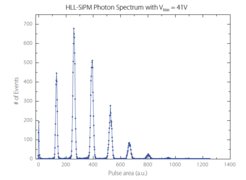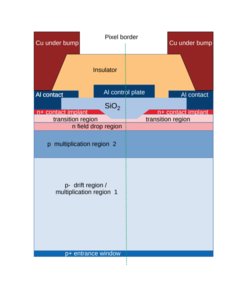Avalanche Detectors
The proper detection of single electrons originated by single optical photons from an ionization process in Silicon is a challenging task. The best state-of-the-art on-chip amplifying devices are limited to roughly one electron noise contribution (rms). This is only possible in very high gain circuits (low capacitance) and with slow signal processing. Both conditions are in many cases not appropriate. To clearly separate the single electron from the noise, an equivalent noise charge (ENC) of at least 0.3 electrons (rms) is needed. This is by far not yet achieved with conventional amplifying devices like JFETs or MOSFETs.
Avalanche amplification detection is based on a completely different principle. In very high electric fields (above 200 kV per centimeter) free charge carries acquire enough energy to generate electron-hole pairs which in turn can generate further carriers. At moderate fields only electrons contribute to this process, leading to a signal which is proportional to the number of original electrons. Amplification factors range up to 1,000 (linear or proportional mode). At higher fields holes can also contribute to this avalanche process. Since the holes drift backwards compared to electrons the process continues until terminated by a breakdown of the external voltage (Geiger mode). The response is essentially binary and the charge released is given by the charge stored in the capacitance of the avalanche structure (105 – 107 electrons).
Both processes are very fast and subnanosecond timing is possible. In proportional mode a low noise amplifier needs to be coupled to the avalanche terminal, while in Geiger mode the signal is already stable enough to be transmitted over a few centimeters of wiring. Since in Geiger mode the response of a single cell is binary, no information on the number of original electrons (or photons) can be extracted. This can be overcome by segmenting the device into many independent cells. If the photon rate per cell is less than one, the output of such an array is proportional to the number of impinging photons (“silicon photomultiplier“, SiPM).
MPG HLL developed several concepts based on the avalanche structures
- Avalanche drift diode
- SiMPl concept
- MARTHA concept



